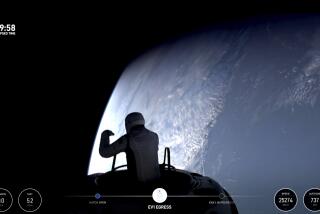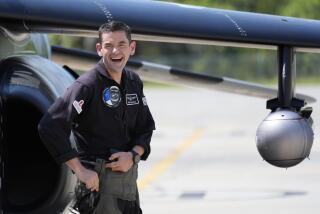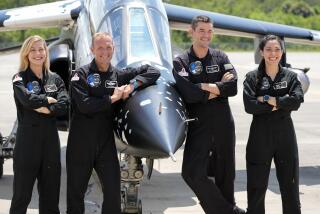Daredevil’s mission to jump from 23 miles above Earth has begun
- Share via
Daredevil Felix Baumgartner is being carried skyward to 120,000 feet, or 23 miles, above Roswell, N.M., in a in bid to achieve supersonic speeds and break the world’s free-fall record jump.
Lifted by a massive helium-filled balloon, Baumgartner is ascending at an average rate of 1,000 feet per minute. The mission launched at 8:30 a.m. PDT and the jump is expected to take place at approximately 11:45 a.m.
The event, called Red Bull Stratos, is being webcast on the event website and in the video stream above. The mission involves two-dozen cameras, including a helmet cam, to catch the action.
Baumgartner’s mission was first set for last Monday and then for last Tuesday, but the attempts were canceled because of high winds. Officials have said an attempt at the feat can be made only if winds on the ground do not exceed 3 mph.
PHOTOS: Preparing for a record breaking jump
It is an endeavor, five years in the making, to break a free-fall world record of 102,800 feet, or 19 miles, set by Air Force test pilot Joe Kittinger in 1960.
The jump by Baumgartner, 43, is designed to test the threshold of his equipment and find out what it shows about the limits and capabilities of the human body bailing out from aircraft at ultra-high altitudes.
Red Bull has paid millions of dollars to Southern California aerospace companies to pull off the mission, but it won’t say exactly how much.
Wearing a newly designed suit and helmet, Baumgartner will be carried skyward inside a pressurized capsule suspended from the largest balloon ever used in a manned flight. Most of the equipment involved was built by Sage Cheshire Inc., a small aerospace firm in Lancaster.
The pressurized capsule, weighing 2,900 pounds — a little more than a Volkswagen Beetle — will be carried by the balloon to an altitude of 23 miles. The trip will take up to three hours, and temperatures will fall as low as minus-70 degrees.
Once Baumgartner jumps from the capsule, he is expected to become supersonic within 35 seconds and ultimately reach about 700 mph.
After free-falling an additional five minutes, Baumgartner is supposed to deploy his parachute. About 15 minutes later, he should reach the ground. His descent is expected to last up to 20 minutes in all.
ALSO:
Next generation of spaceflight taking shape in Mojave
Winds blamed as attempt to break free-fall record is aborted
SpaceX capsule arrives at space station on key resupply mission
More to Read
Inside the business of entertainment
The Wide Shot brings you news, analysis and insights on everything from streaming wars to production — and what it all means for the future.
You may occasionally receive promotional content from the Los Angeles Times.











